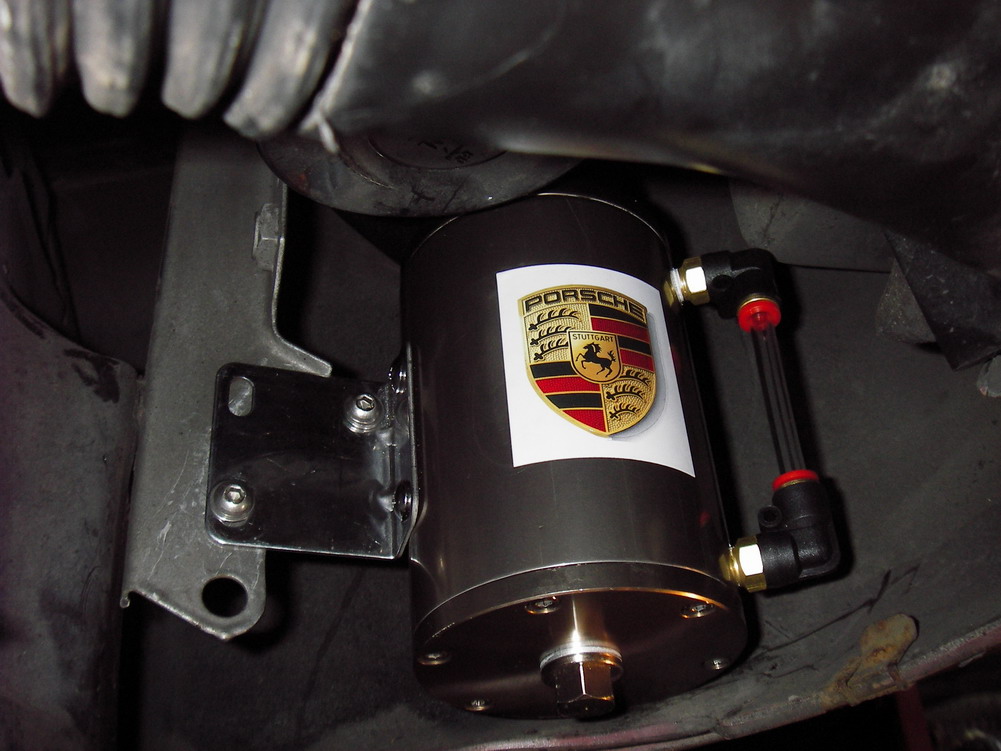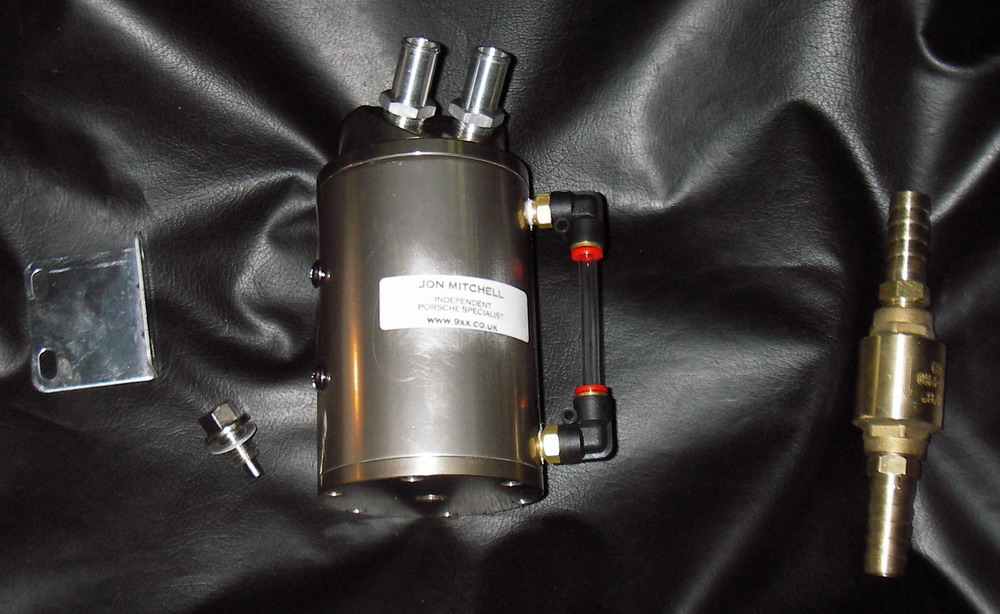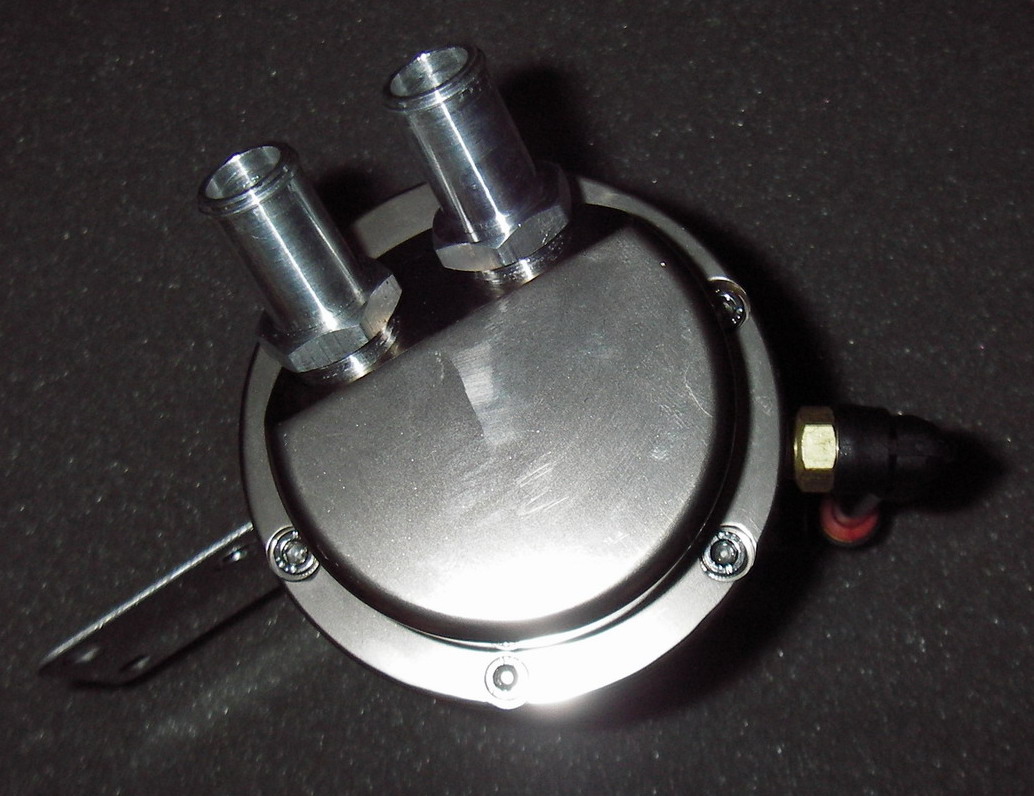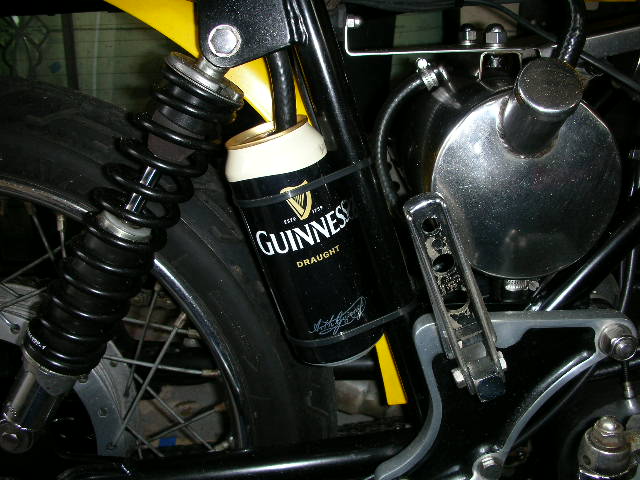You should upgrade or use an alternative browser.
New shiny things
- Thread starter 944Turbo
- Start date
Anyway It is a recirculating oil catch tank with a one way valve to stop the boost from blowing back the wrong way when the dump valve dumps at high rpm. I have wanted one for a while because the metal oil vent pipe that runs under the inlet manifold gets all bunged up with carbon and scale and on the turbo this exits just infront of the turbo, I think ingesting that stuff at high rpm was what destroyed my original turbo.
I also expect to see a reduction in the oily film that forms within the intake system. (hard pipes, intercooler, inlet manifold)
I wanted recirculating rather than vent to atmosphere as it reduces pressure within the crankcase.
Here is a pic of it fitted, it is in the front left hand corner (near the horns) and I can see the sight glass through the grill. I made a hole in the undertray (and filled it again with a grommet) for easy emptying. Jon supplies a magnetic drain plug to catch any bits - probably overkill but why not. It is very nicely made and I am impressed so far! Now to get some road tax and go for a drive [
Tony

Diver944
Active member
ORIGINAL: Fen
I like the sight glass. Makes it look like a Porsche tankard in the last pic.
[
Indi9xx
New member
I cant take all the credit though, I had help in the design from PenskeRacing and the motorsport side of Ilmor-Penske, along with input from some of the ex Cosworth WRC team.
I am also glad you went for the closed loop mode breathers, which is more efficient and better for your engine. But luckily they can be used either open (non recirculating) or closed loop (recirculating).
They can be mounted in a visible position, as Rick has done with his Lindsey catch can... Depends if you want stealth or not. (I like stealth myself)
![. [FONT=verdana,geneva"] [FONT=verdana,geneva"]](/forum/styles/default/pcgb/space.gif)
![. [FONT=verdana,geneva"] [FONT=verdana,geneva"]](/forum/styles/default/pcgb/space.gif)
eastendr
New member
ORIGINAL: Fen
(Rick likes his stealth too much [][
][
]
![. [FONT=verdana,geneva"] [FONT=verdana,geneva"]](/forum/styles/default/pcgb/space.gif)
![. [FONT=verdana,geneva"] [FONT=verdana,geneva"]](/forum/styles/default/pcgb/space.gif)
Yeah Right. Just call me the stealthmeister [
sawood12
New member
Tony
![. [FONT=verdana,geneva"] [FONT=verdana,geneva"]](/forum/styles/default/pcgb/space.gif)
![. [FONT=verdana,geneva"] [FONT=verdana,geneva"]](/forum/styles/default/pcgb/space.gif) I think the Lindsey blurb for theirs is saying that oil vapour in the intake charge effectively displaces some air, making the mixture subtly different than it otherwise should be. With the atmospheric one you are supposed to drill out the restriction Porsche placed in the OE breather and I suspect those who have had problems didn't do that since mine seems to be fine as far as I can tell. I don't get any smells either, but I can see how that would not be a good thing if I did.
I think the Lindsey blurb for theirs is saying that oil vapour in the intake charge effectively displaces some air, making the mixture subtly different than it otherwise should be. With the atmospheric one you are supposed to drill out the restriction Porsche placed in the OE breather and I suspect those who have had problems didn't do that since mine seems to be fine as far as I can tell. I don't get any smells either, but I can see how that would not be a good thing if I did.![. [FONT=verdana,geneva"] [FONT=verdana,geneva"]](/forum/styles/default/pcgb/space.gif)
![. [FONT=verdana,geneva"] [FONT=verdana,geneva"]](/forum/styles/default/pcgb/space.gif) I'd be interested to hear if there is something at play here that I am not familiar with especially as I can't say I'm convinced by that either argument, but at least I know my new turbo, hard pipes and intercooler shouldn't have oil misted all through them.
I'd be interested to hear if there is something at play here that I am not familiar with especially as I can't say I'm convinced by that either argument, but at least I know my new turbo, hard pipes and intercooler shouldn't have oil misted all through them.![. [FONT=verdana,geneva"] [FONT=verdana,geneva"]](/forum/styles/default/pcgb/space.gif)
![. [FONT=verdana,geneva"] [FONT=verdana,geneva"]](/forum/styles/default/pcgb/space.gif) Yes, Scott, you do have to drain the can periodically. I typically get very little out of mine when it's checked, unless the oil has been slightly overfilled (and max on the dipstick seems to qualify as the very edge of too much) as any extra just gets dumped straight into the can. Mine has a 1/4" NPT fitting on the bottom with a stainless air line on it running down to the chassis leg and a ball valve at the bottom. The valve gets cracked every time the car is on a ramp and it usually has 1/4 cup at most in it. I really like Tony's sight glass though as I have to get under my car to see if there is anything in mine.
Yes, Scott, you do have to drain the can periodically. I typically get very little out of mine when it's checked, unless the oil has been slightly overfilled (and max on the dipstick seems to qualify as the very edge of too much) as any extra just gets dumped straight into the can. Mine has a 1/4" NPT fitting on the bottom with a stainless air line on it running down to the chassis leg and a ball valve at the bottom. The valve gets cracked every time the car is on a ramp and it usually has 1/4 cup at most in it. I really like Tony's sight glass though as I have to get under my car to see if there is anything in mine.![. [FONT=verdana,geneva"] [FONT=verdana,geneva"]](/forum/styles/default/pcgb/space.gif)
"The greater the pressure differential across the rings, the better they seal. The better they seal, the less blowby/leakdown. The less blowby, the more power. Many purpose-built race engines use vacuum pumps to constantly evacuate the crankcase and keep as much vacuum as possible. I've seen cars gain 10+ hp with a vacuum pump on the crankcase."
Looks like my memory automatically halved the rennlist gain! (but forgot the bit about a vacuum pump)[
Tony
Indi9xx
New member
This is partly due to increased boost pressure on gear changes being dumped by the bypass valve (aka Dump valve, or BOV or BPV) into the turbo to air flow meter J-pipe faster than the engine at that point (closed throttle) can can consume it, causing a positive pressure wave to travel up the breathers, as well as into the turbo and airflow meter. This is defeated by the use of either a atmospheric venting catch can, or a closed loop system with a check valve. The other benefit of a catch can in this respect is that these spikes of pressure see the catch can almost as a capacitor, damping out these waves as they expand into the catch tank.
This pressure wave, travels into the engine block, causing gaskets and seals to weap oil.
The other problem, is that as boost increases, blow by gasses increase, which due to the gas volume as velocity, carries large oil particles through the breathers, into the intake, where they clog the intercooler, cause carbon build up in the head and worst of all, cause a double wammy of potential damage to the turbo (oil droplets hitting the compressor wheel which runs at 120,000 rpm and carbon build up on the hot side turbine) These particles of oil are inevitable and the volume of oil increases with the volume of blowby gasses, which will increase with combustion pressure and engine wear.. A catch can will catch these droplets as they are forced to drop out of the airstream in a catch can. Also due to a catch can being ideally mounted in a cool location, oil vapour will be encoraged to condense within the catch can.
The benefits of negative crankcase pressure...
1. Piston rings rely on having a higher pressure above the ring, than bellow the ring, as the ring grove and ring is designed to spread the ring out (expand it) the more downward force thats applied to it. Of course during combustion there is plenty of force pushing down on the piston ring... But the less pressure bellow the ring, the more expanding pressure on the ring, and therefore more sealing. So even during combustion, negative crankcase pressure assists piston ring sealing, less blowby and therefore more combustion pressure applied to the piston crown. In addition, negative crankcase pressure also assists ring sealing during the intake, exhaust and compression strokes.
2. Air displacement. With each revolution of an engine, each piston is trying to push a volume of air bellow a piston out of its way and also then pulling air back behind it as it rockets back up the bore. Luckily, in an engine, as one piston rises, another one is falling. But the underside of the piston is still trying to move air. With every rotation of the crank, a 2.0 litre 4 cylinder engine is trying to push 500cc of air out of its way as a piston goes down a bore, and then pull 500cc of air back as it rises back up the bore... Think of this happening at a rate of 6000 cycles per min for 6000 rpm, which is 100 cycles per second, which means the piston is trying to move a total of 50 litres of air per second. Reduce the pressure of this air, even by a minute amount and you reduce the amount of effort required to perform.
3. There are also aerodynamic considerations. The higher the air pressure, the more importance aerodynamics are to an item.. the lower the air pressure, the less important aerodynamics become. Within the engine you have a crankshaft which rotates at 100 revs per second, conrods which are chopping their way through air and pistons moving through the air.. lower the air pressure and these items will see less resistance. Negative crankcase pressure will again improve the reduction of losses within the engine due to aerodynamic drag.
4. Engine sealing... Negative crankcase pressure will avoid engine leaks oil leaks, as there will be no force trying to push the oil past gaskets and seals, only atmospheric pressure trying to push air from the outside world into the engine.
5. Thrust. This can be a double edged sword... On the combustion and intake strokes, negative crankcase pressure will assist in pulling the piston down the bore.. even on PSI means that you will gain a pound of pressure pushing the piston down the bore for every square inch of the piston crown... However... on the exhaust and compression strokes, this works against you, so you make losses for every gain when dealing with this issue (so ok.. not really a benefit, but worth mentioning)
Is there a vacuum between the turbo and the air flow metering device? (barn door or maf)... yes.. both at high rpm and low rpm, both on boost and off boost... the higher the rate of air consumption of an engine, the more negative pressure created. This is because you always have see a pressure drop, otherwise air would not be moving... Also remember that at high rpm and boost, the engine is trying to consume massive amounts of air.. this air is having to fight its way through an air filter and all air filters cause a pressure drop, even a super carlos fandango model (also available in red) sold by MaxPowerMotorsport or the bloke at the local market. Even if this pressure drop was just 1 milibar, its a form of energy thats there for free and the crankcase will benefit from.
So all in all... I am a great believer in negative crankcase pressure as you can guess from the above.. I may be missguided, but it works for me.

Posts made and opinions expressed are those of the individual forum members
Use of the Forum is subject to the Terms and Conditions
Disclaimer
The opinions expressed on this site are not necessarily those of the Club, who shall have no liability in respect of them or the accuracy of the content. The Club assumes no responsibility for any effects arising from errors or omissions.
Porsche Club Great Britain gives no warranties, guarantees or assurances and makes no representations or recommendations regarding any goods or services advertised on this site. It is the responsibility of visitors to satisfy themselves that goods and/or services supplied by any advertiser are bona fide and in no instance can the Porsche Club Great Britain be held responsible.
When responding to advertisements please ensure that you satisfy yourself of any applicable call charges on numbers not prefixed by usual "landline" STD Codes. Information can be obtained from the operator or the white pages. Before giving out ANY information regarding cars, or any other items for sale, please satisfy yourself that any potential purchaser is bona fide.
Directors of the Board of Porsche Club GB, Club Office Staff, Register Secretaries and Regional Organisers are often requested by Club members to provide information on matters connected with their cars and other matters referred to in the Club Rules. Such information, advice and assistance provided by such persons is given in good faith and is based on the personal experience and knowledge of the individual concerned.
Neither Porsche Club GB, nor any of the aforementioned, shall be under any liability in respect of any such information, advice or assistance given to members. Members are advised to consult qualified specialists for information, advice and assistance on matters connected with their cars at all times.











